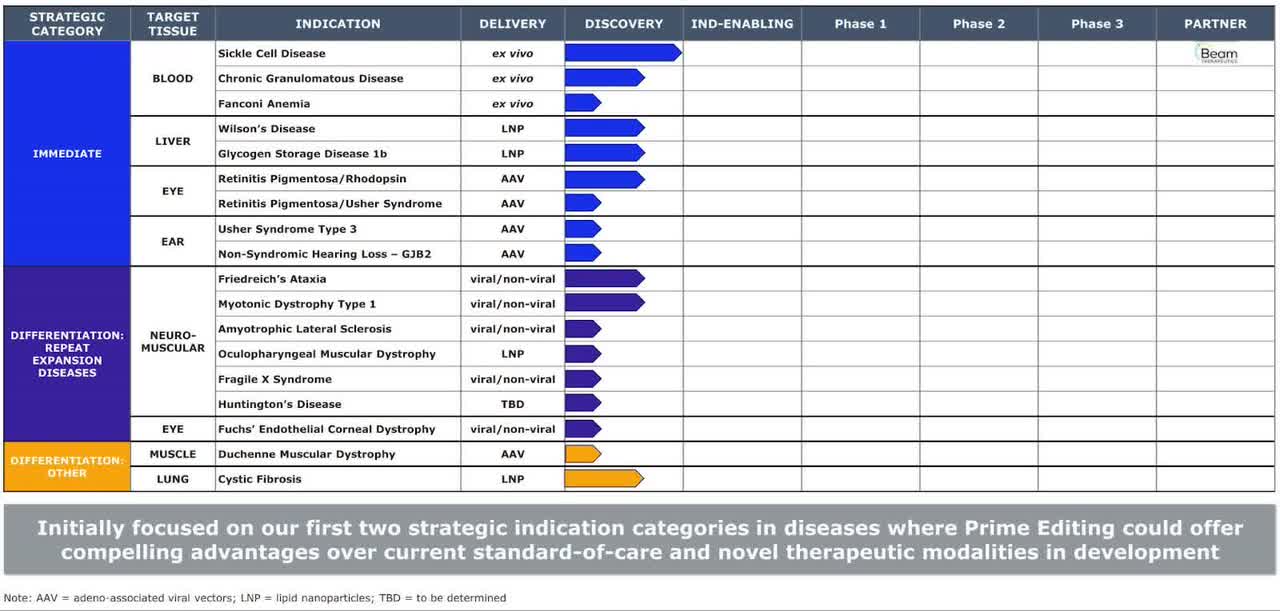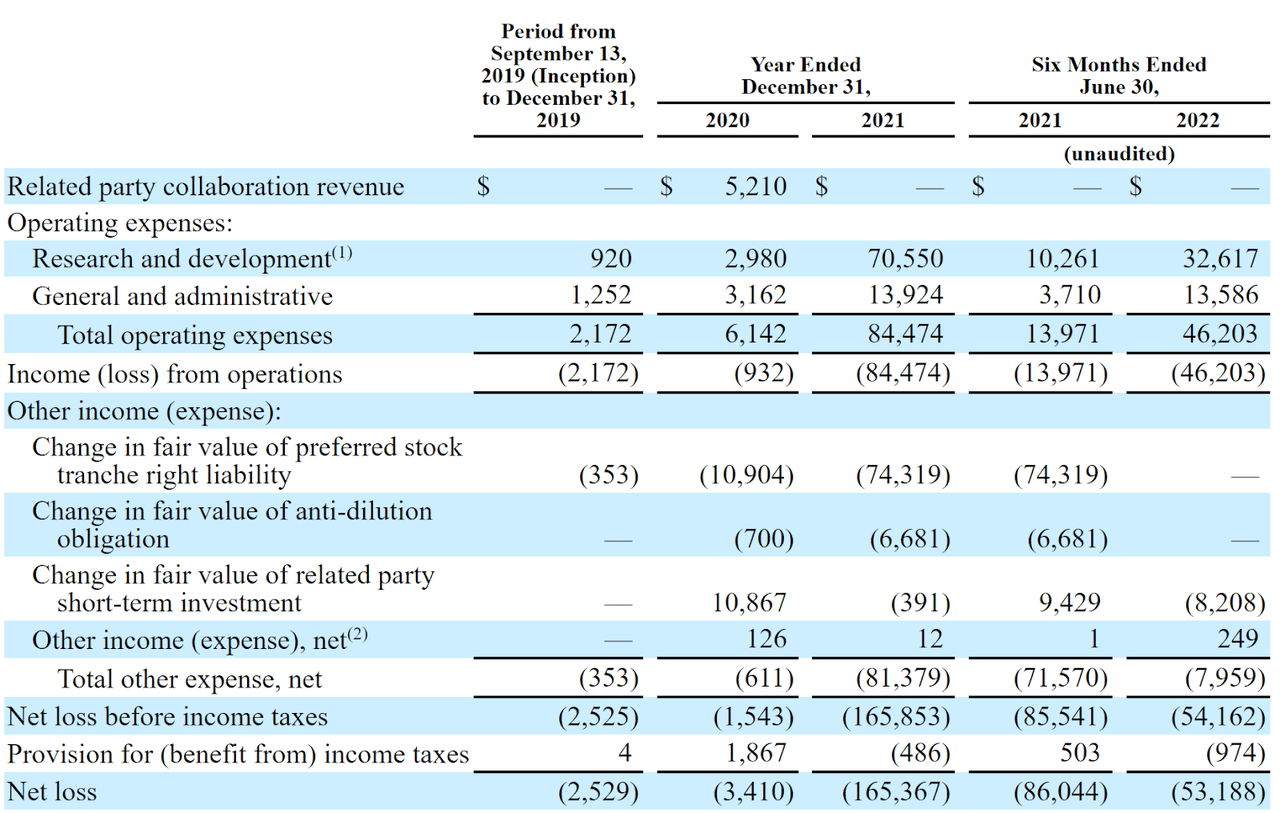Godji10
What Is Prime Medicine?
Cambridge, Massachusetts-based Prime (PRME) was founded to develop its Prime Editing technologies in-licensed from the Broad Institute, some of which have been granted a patent, which may enable the creation of genetic editing treatments for diseases such as Sickle Cell Disease, Wilson’s Disease, and various neuromuscular diseases.
Management is headed by President and CEO Keith Gottesdiener, M.D., who has been with the firm since July 2020 and was previously CEO of Rhythm Pharmaceuticals after leading Merck’s late clinical development organization.
The firm’s lead program, which is still in discovery phase, is seeking to treat Sickle Cell Disease.
It is one of currently 18 programs, of which 17 are being developed solely in-house and the 18th, its Sickle Cell Disease, is being developed in partnership with Beam Therapeutics.
Below is the current status of the company’s drug development pipeline:
Company Pipeline (SEC EDGAR)
Prime has booked fair market value investment of $425.5 million as of June 30, 2022, from investors, including GV (f.k.a. Google Ventures), ARCH Venture Partners, F-Prime Capital Partners and Newpath Partners.
Prime’s Market & Competition
According to a 2018 market research report by Grand View Research, the market for sickle cell disease treatment is expected to reach $5.5 billion by 2023.
This represents a forecast CAGR (Compound Annual Growth Rate) of CAGR (Compound Annual Growth Rate) of 14.3% from 2019 to 2023.
Key elements driving this expected growth are a growing patient pool size leading to increased demand and development of potential new drugs in late stages, including voxelotor, crizanlizumab, Altemia and rivipansel.
Also, currently available treatments for sickle cell disease typically provide only symptomatic relief and palliative care, such as blood transfusions, pharmacotherapy and bone marrow transplants.
Major competitive vendors that provide or are developing related treatments include:
-
bluebird bio
-
CRISPR Therapeutics
-
Editas Medicine
-
Intellia Therapeutics
-
Sangamo Therapeutics
-
AVROBio
-
Freeline Therapeutics
-
Others
Prime’s IPO Date & Details
The initial public offering date, or IPO, for Prime Medicine is expected to be October 19, 2022, and scheduled to be available for investors to trade on the open market starting October 20, 2022.
(Warning: Compared to stocks with more history, IPOs typically have less information for investors to review and analyze. For this reason, investors should use caution when thinking about investing in an IPO, or immediately post-IPO. Also, investors should keep in mind that many IPOs are heavily marketed, past company performance is not a guarantee of future results and potential risks may be understated.)
PRME intends to sell 8.9 million shares of common stock at a proposed midpoint price of $17.00 per share for gross proceeds of approximately $151.3 million, not including the sale of customary underwriter options.
No existing or potentially new shareholders have indicated an interest to purchase shares at the IPO price.
Assuming a successful IPO at the midpoint of the proposed price range, the company’s enterprise value at IPO (excluding underwriter options) would approximate $1.4 billion.
The float to outstanding shares ratio (excluding underwriter options) will be approximately 9.43%. A figure under 10% is generally considered a ‘low float’ stock which can be subject to significant price volatility.
Per the firm’s most recent regulatory filing, it plans to use the net proceeds as follows:
approximately $90.0 million for continued research and development of our Prime Editing portfolio, including preclinical studies and advancement through potential preclinical proof-of-concept;
approximately $65.0 million for IND-enabling studies and the potential initiation of clinical studies for certain of our current therapeutic programs;
approximately $65.0 million for continued advancement of our Prime Editing platform and discovery-stage research for other potential programs;
approximately $50.0 million to develop our early-stage manufacturing processes and build out our dedicated chemistry facility; and
the remainder for general corporate purposes.
Based on our current plans, we believe our existing cash and cash equivalents and short-term investments, together with the net proceeds from this offering, will be sufficient to fund our operating expenses and capital expenditure requirements into 2025.
(Source – SEC)
Management’s presentation of the company roadshow is available here until the IPO is completed.
Management says the firm is not subject to any legal proceedings that it believes would have a material adverse effect on its business.
Listed underwriters of the IPO are J.P. Morgan, Goldman Sachs, Morgan Stanley and Jefferies.
How To Invest In The Company’s Stock: 7 Steps
Investors can buy shares of the stock in the same way they may buy stocks of other publicly traded companies, or as part of the pre-IPO allocation.
Note: This report is not a recommendation to purchase stock or any other security. For investors who are interested in pursuing a potential investment after the IPO is complete, the following steps for buying stocks will be helpful.
Step 1: Understand The Company’s Financial History
Although there is not much public financial information available about the company, investors can look at the company’s financial history on their form S-1 or F-1 SEC filing (Source).
Step 2: Assess The Company’s Financial Reports
The primary financial statements available for publicly-traded companies include the income statement, balance sheet, and statement of cash flows. These financial statements can help investors learn about a company’s cash capitalization structure, cash flow trends and financial position.
My summary of the firm’s recent financial results is below:
The firm’s recent financial results are typical for a development-stage biopharma in that it has received no revenue (except for some collaboration revenue in 2020) and has had significant R&D and G&A expenses associated with its discovery efforts.
Below are the company’s financial results for the past two and 1/2 years:
Company Statement Of Operations (SEC EDGAR)
As of June 30, 2022, the company had $92.2 million in cash and $46.9 million in total liabilities.
Step 3: Evaluate The Company’s Potential Compared To Your Investment Horizon
When investors evaluate potential stocks to buy, it’s important to consider their time horizon and risk tolerance before buying shares. For example, a swing-trader may be interested in short-term growth potential, whereas a long-term investor may prioritize strong financials ahead of short-term price movements.
Step 4: Select A Brokerage
Investors who do not already have a trading account will begin with the selection of a brokerage firm. The account types commonly used for trading stocks include a standard brokerage account or a retirement account like an IRA.
Investors who prefer advice for a fee can open a trading account with a full-service broker or an independent investment advisor and those who want to manage their portfolio for a reduced cost may choose a discount brokerage company.
Step 5: Choose An Investment Size And Strategy
Investors who have decided to buy shares of company stock should consider how many shares to purchase and what investment strategy to adopt for their new position. The investment strategy will guide an investor’s holding period and exit strategy.
Many investors choose to buy and hold stocks for lengthy periods. Examples of basic investing strategies include swing trading, short-term trading or investing over a long-term holding period.
For investors wishing to gain a pre-IPO allocation of shares at the IPO price, they would ‘indicate interest’ with their broker in advance of the IPO. Indicating an interest is not a guarantee that the investor will receive an allocation of pre-IPO shares.
Step 6: Choose An Order Type
Investors have many choices for placing orders to purchase stocks, including market orders, limit orders and stop orders.
-
Market order: This is the most common type of order made by retail traders. A market order executes a trade immediately at the best available transaction price.
-
Limit order: When an investor places a buy limit order, they specify a maximum price to be paid for the shares.
-
Stop order: A buy-stop order is an order to buy at a specified price, known as the stop price, which will be higher than the current market price. In the case of buy-stop, the stop price will be lower than the current market price.
Step 7: Submit The Trade
After investors have funded their account with cash, they may decide on an investment size and order type, then submit the trade to place an order. If the trade is a market order, it will be filled immediately at the best available market price.
However, if investors submit a limit order or stop order, the investor may have to wait until the stock reaches their target price or stop-loss price for the trade to be completed.
The Bottom Line
Prime is seeking public capital market funding to advance its large pipeline beyond discovery phase and ultimately into Phase 1 trials.
Its lead candidate, a genetic treatment for sickle cell disease, is still in discovery phase.
The market opportunities for the various diseases the firm is seeking to treat are large and diversified.
The company has a major pharma firm collaboration with Beam Therapeutics for developing its lead genetic treatment candidate for sickle cell disease.
The firm’s investor syndicate includes well-known life science venture capital firm, ARCH Venture Partners.
J.P. Morgan is the lead underwriter, and IPOs led by the firm over the last 12-month period have generated an average return of negative (35.5%) since their IPO. This is a lower-tier performance for all major underwriters during the period.
As for valuation, management is asking investors to pay an enterprise value of $1.4 billion at IPO, which is well above the normal range for a biopharma firm at IPO.
Prime has a large pipeline of potential genetic treatment candidates.
However, given the company’s pipeline is all pre-Phase 1 trials, the IPO is extremely high risk, very high priced and the firm has a very long road ahead before its first candidate is approved.
Therefore, my outlook on the Prime Medicine IPO is on Hold.


Be the first to comment